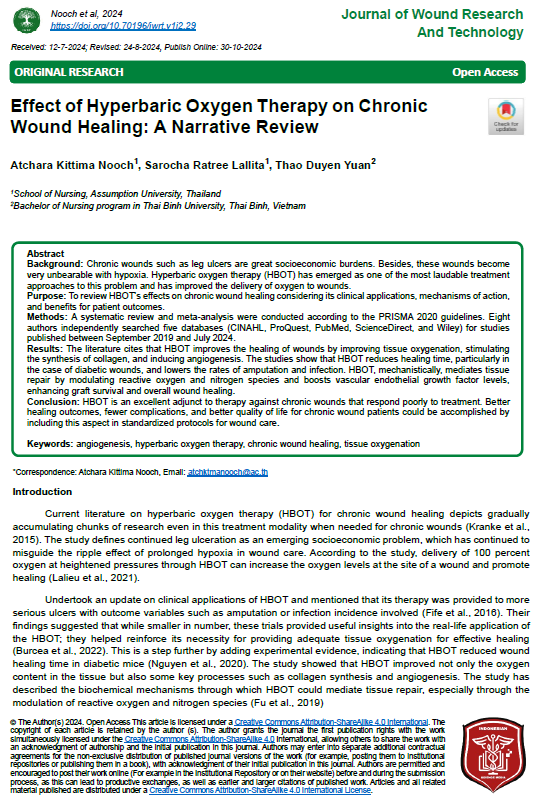Effect of Hyperbaric Oxygen Therapy on Chronic Wound Healing: A Narrative Review
DOI:
https://doi.org/10.70196/jwrt.v1i2.29Keywords:
angiogenesis, hyperbaric oxygen therapy, chronic wound healing, tissue oxygenationAbstract
Background: Chronic wounds such as leg ulcers are great socioeconomic burdens. Besides, these wounds become very unbearable with hypoxia. Hyperbaric oxygen therapy (HBOT) has emerged as one of the most laudable treatment approaches to this problem and has improved the delivery of oxygen to wounds.
Purpose: To review HBOT's effects on chronic wound healing considering its clinical applications, mechanisms of action, and benefits for patient outcomes.
Methods: A systematic review and meta-analysis were conducted according to the PRISMA 2020 guidelines. Eight authors independently searched five databases (CINAHL, ProQuest, PubMed, ScienceDirect, and Wiley) for studies published between September 2019 and July 2024.
Results: The literature cites that HBOT improves the healing of wounds by improving tissue oxygenation, stimulating the synthesis of collagen, and inducing angiogenesis. The studies show that HBOT reduces healing time, particularly in the case of diabetic wounds, and lowers the rates of amputation and infection. HBOT, mechanistically, mediates tissue repair by modulating reactive oxygen and nitrogen species and boosts vascular endothelial growth factor levels, enhancing graft survival and overall wound healing.
Conclusion: HBOT is an excellent adjunct to therapy against chronic wounds that respond poorly to treatment. Better healing outcomes, fewer complications, and better quality of life for chronic wound patients could be accomplished by including this aspect in standardized protocols for wound care.
Downloads
References
Alam, W., Hasson, J., & Reed, M. (2021). Clinical approach to chronic wound management in older adults. Journal of the American Geriatrics Society, 69(8), 2327–2334. https://doi.org/10.1111/jgs.17177
Burcea, A., Mihai, L. L., Bechir, A., Suciu, M., & Bechir, E. S. (2022). Clinical Assessment of the Hyperbaric Oxygen Therapy Efficacy in Mild to Moderate Periodontal Affections: A Simple Randomised Trial. Medicina, 58(2), 234. https://doi.org/10.3390/medicina58020234
Burhan, A., Ali Khusein, N. bin, & Sebayang, S. M. (2022). Effectiveness of negative pressure wound therapy on chronic wound healing: A systematic review and meta-analysis. Belitung Nursing Journal, 8(6), 470–480. https://doi.org/10.33546/bnj.2220
Effan Fahri Mahendra, R., Burhan, A., & Susanti, I. (2024). An analysis of various wound washing methods and their efficacy in treating chronic wounds: A comprehensive review of existing literature. Journal of Wound Research and Technology, 1(1), 1–8. https://doi.org/10.70196/jwrt.v1i1.2
Fife, C. E., Eckert, K. A., & Carter, M. J. (2016). An Update on the Appropriate Role for Hyperbaric Oxygen: Indications and Evidence. Plastic & Reconstructive Surgery, 138(3S), 107S-116S. https://doi.org/10.1097/PRS.0000000000002714
Flegg, J. A., McElwain, D. L. S., Byrne, H. M., & Turner, I. W. (2009). A Three Species Model to Simulate Application of Hyperbaric Oxygen Therapy to Chronic Wounds. PLoS Computational Biology, 5(7), e1000451. https://doi.org/10.1371/journal.pcbi.1000451
Fu, X., Ding, H., Miao, W., Mao, C., Zhan, M., & Chen, H. (2019). Global recurrence rates in diabetic foot ulcers: A systematic review and meta‐analysis. Diabetes/Metabolism Research and Reviews, 35(6), e3160. https://doi.org/10.1002/dmrr.3160
Goldman, R. J. (2009). Hyperbaric Oxygen Therapy for Wound Healing and Limb Salvage: A Systematic Review. PM&R, 1(5), 471–489. https://doi.org/10.1016/j.pmrj.2009.03.012
Huang, X., Liang, P., Jiang, B., Zhang, P., Yu, W., Duan, M., Guo, L., Cui, X., Huang, M., & Huang, X. (2020). Hyperbaric oxygen potentiates diabetic wound healing by promoting fibroblast cell proliferation and endothelial cell angiogenesis. Life Sciences, 259, 118246. https://doi.org/10.1016/j.lfs.2020.118246
Jones, J. (2005). Winter’s concept of moist wound healing: A review of the evidence and impact on clinical practice. Journal of Wound Care, 14(6), 273–276. https://doi.org/10.12968/jowc.2005.14.6.26794
Kranke, P., Bennett, M. H., Martyn-St James, M., Schnabel, A., Debus, S. E., & Weibel, S. (2015). Hyperbaric oxygen therapy for chronic wounds. Cochrane Database of Systematic Reviews. https://doi.org/10.1002/14651858.CD004123.pub4
Lalieu, R. C., Akkerman, I., & Van Hulst, R. A. (2021). Hyperbaric Oxygen Therapy for Venous Leg Ulcers: A 6 Year Retrospective Study of Results of a Single Center. Frontiers in Medicine, 8, 671678. https://doi.org/10.3389/fmed.2021.671678
Mixrova Sebayang, S., & Burhan, A. (2024). Comparison of Effectiveness of Hydropobic Cutimed Sorbact Versus Cadexomer Iodine 0.9% on Healing of Diabetic Foot Ulcer: A Randomized Control Trial. Journal of Wound Research and Technology, 1(1), 28–37. https://doi.org/10.70196/jwrt.v1i1.5
Nguyen, T. T., Jones, J. I., Wolter, W. R., Pérez, R. L., Schroeder, V. A., Champion, M. M., Hesek, D., Lee, M., Suckow, M. A., Mobashery, S., & Chang, M. (2020). Hyperbaric oxygen therapy accelerates wound healing in diabetic mice by decreasing active matrix metalloproteinase‐9. Wound Repair and Regeneration, 28(2), 194–201. https://doi.org/10.1111/wrr.12782
Oley, M. H., Oley, M. C., Iskandar, A. A. A., Toreh, C., Tulong, M. T., & Faruk, M. (2021). Hyperbaric Oxygen Therapy for Reconstructive Urology Wounds: A Case Series. Research and Reports in Urology, Volume 13, 841–852. https://doi.org/10.2147/RRU.S331161
Ortega, M. A., Fraile-Martinez, O., García-Montero, C., Callejón-Peláez, E., Sáez, M. A., Álvarez-Mon, M. A., García-Honduvilla, N., Monserrat, J., Álvarez-Mon, M., Bujan, J., & Canals, M. L. (2021). A General Overview on the Hyperbaric Oxygen Therapy: Applications, Mechanisms and Translational Opportunities. Medicina, 57(9), 864. https://doi.org/10.3390/medicina57090864
Peña-Villalobos, I., Casanova-Maldonado, I., Lois, P., Prieto, C., Pizarro, C., Lattus, J., Osorio, G., & Palma, V. (2018). Hyperbaric Oxygen Increases Stem Cell Proliferation, Angiogenesis and Wound-Healing Ability of WJ-MSCs in Diabetic Mice. Frontiers in Physiology, 9, 995. https://doi.org/10.3389/fphys.2018.00995
Penn, J. S., Madan, A., Caldwell, R. B., Bartoli, M., Caldwell, R. W., & Hartnett, M. E. (2008). Vascular endothelial growth factor in eye disease. Progress in Retinal and Eye Research, 27(4), 331–371. https://doi.org/10.1016/j.preteyeres.2008.05.001

Downloads
Published
How to Cite
Issue
Section
License
Copyright (c) 2024 Atchara Kittima Nooch, Sarocha Ratree Lallita, Thao Duyen Yuan

This work is licensed under a Creative Commons Attribution-ShareAlike 4.0 International License.
